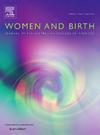助产士创伤护理视频培训项目的效果:一项随机对照试验。
IF 4.1
2区 医学
Q1 NURSING
引用次数: 0
摘要
背景:助产士的创伤知情护理(TIC)有可能预防围产期妇女的再创伤,并支持助产士的心理健康。制定和评估无障碍的TIC培训计划可以促进TIC融入助产护理。目的:为助产士开发一个基于TIC视频的培训项目,并检查其在改善助产士结果方面的效果。方法:采用平行组设计,考察开发的TIC视频训练方案的效果。在一个面向高危围产期妇女的高级医疗护理医院招募助产士,为期一个月。然后按1:1的比例随机分配到干预组或对照组。干预组的参与者在两个月内单独参加了该计划,而等候名单对照组在研究期结束后提供了相同的计划。主要结局指标是助产士对TIC的态度(artici -10)。次要结局指标为心理安全(心理安全量表)和职业倦怠(职业成就感指数)。为了检验干预效果,我们比较了各组间随时间的变化。结果:42名助产士(每组21名)参与了研究。在三个月干预后,干预组明显改善他们的态度抽搐(p = 0.02[95 % CI, 0.07, 0.86]),职场心理安全(p = 0.01[95 % CI, 0.11, 0.89])和减少倦怠人际分离(p = 0.008[95 % CI, -0.74 - 0.12])。结论:个性化视频培训提高了助产士的TIC态度、心理安全感和职业倦怠。需要进一步的研究来检查组织一级的执行情况。本文章由计算机程序翻译,如有差异,请以英文原文为准。
The effect of a trauma-informed care video training program for midwives: A randomized controlled trial
Background
Trauma-informed care (TIC) by midwives has the potential to prevent re-traumatization among perinatal women and support midwives’ mental health. The development and evaluation of accessible TIC training programs could facilitate the integration of TIC into midwifery care.
Aim
To develop a TIC video-based training program for midwives and to examine its effects in improving midwives' outcomes.
Method
A parallel group design was conducted to investigate the effect of a developed TIC video training program. Midwives in an advanced medical care hospital for high-risk perinatal women were recruited over a one-month period. They were then randomly assigned to an intervention or control group in a 1:1 ratio. Participants in the intervention group accessed the program individually over two months, while the waitlist control group was offered the same program after the study period. The primary outcome measure was the midwives’ attitudes toward TIC (ARTIC-10). The secondary outcome measures were psychological safety (Psychological Safety Scale) and burnout (Professional Fulfillment Index). To examine the intervention effect, we compared changes over time between groups.
Results
Forty-two midwives (21per group) participated in the study. At three months post-intervention, the intervention group showed a significant improvement in their attitudes toward TIC(p = 0.02 [95 % CI, 0.07, 0.86]), workplace psychological safety (p = 0.01 [95 % CI, 0.11, 0.89]) and decreased burnout interpersonal disengagement (p = 0.008 [95 % CI, −0.74,- 0.12]).
Conclusion
The individual video-based TIC training improved midwives’ TIC attitudes, psychological safety, and burnout. Future studies are needed to examine implementation at the organisational level.
求助全文
通过发布文献求助,成功后即可免费获取论文全文。
去求助
来源期刊

Women and Birth
NURSING-OBSTETRICS & GYNECOLOGY
CiteScore
7.20
自引率
13.20%
发文量
371
审稿时长
27 days
期刊介绍:
Women and Birth is the official journal of the Australian College of Midwives (ACM). It is a midwifery journal that publishes on all matters that affect women and birth, from pre-conceptual counselling, through pregnancy, birth, and the first six weeks postnatal. All papers accepted will draw from and contribute to the relevant contemporary research, policy and/or theoretical literature. We seek research papers, quality assurances papers (with ethical approval) discussion papers, clinical practice papers, case studies and original literature reviews.
Our women-centred focus is inclusive of the family, fetus and newborn, both well and sick, and covers both healthy and complex pregnancies and births. The journal seeks papers that take a woman-centred focus on maternity services, epidemiology, primary health care, reproductive psycho/physiology, midwifery practice, theory, research, education, management and leadership. We also seek relevant papers on maternal mental health and neonatal well-being, natural and complementary therapies, local, national and international policy, management, politics, economics and societal and cultural issues as they affect childbearing women and their families. Topics may include, where appropriate, neonatal care, child and family health, women’s health, related to pregnancy, birth and the postpartum, including lactation. Interprofessional papers relevant to midwifery are welcome. Articles are double blind peer-reviewed, primarily by experts in the field of the submitted work.
 求助内容:
求助内容: 应助结果提醒方式:
应助结果提醒方式:


